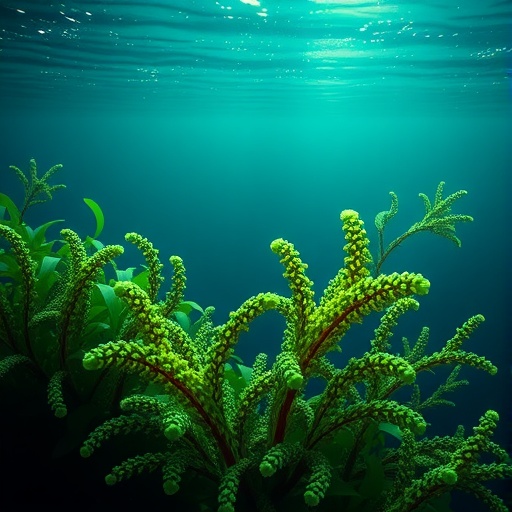In an increasingly climate-conscious world, the quest for sustainable and renewable energy sources has never been more critical. Among these, microalgae have emerged as a promising alternative due to their high biomass yield and capacity for carbon dioxide absorption. The challenge, however, remains in accurately estimating these biomass levels efficiently and at scale. Recent research led by Kolawole et al. proposes a groundbreaking methodology that harnesses the combined power of Ant Colony Optimization (ACO) and random forest algorithms to enhance the estimation of microalgae biomass using multispectral imaging.
The study, set to be published in the journal “Environmental Monitoring and Assessment,” highlights the synergy between advanced computational techniques and environmental monitoring. Traditional methods of biomass estimation, often labor-intensive and time-consuming, fall short when dealing with large datasets typical of microalgal research environments. This research introduces a hybrid framework that promises to change the game by providing a scalable solution to biomass estimation challenges.
At the core of the proposed framework lies the Ant Colony Optimization algorithm, which mimics the foraging behavior of ants. This algorithm is particularly effective at solving optimization problems, thereby streamlining the process of identifying patterns in complex datasets gathered from multispectral imaging. By utilizing a nature-inspired approach, this method not only enhances the efficiency of data processing but also improves the accuracy of biomass estimation.
The integration of random forest algorithms further bolsters the robustness of the framework. Random forests, a type of ensemble learning method, operate by creating multiple decision trees and aggregating their results. This method minimizes the risk of overfitting, a common issue in predictive modeling, thereby yielding reliable and generalizable outcomes. By combining these two powerful techniques, the researchers have developed a method that stands out in terms of both speed and precision.
In their work, Kolawole et al. conducted extensive experiments to validate their hybrid ACO-random forest framework. Using datasets derived from multispectral images of microalgae cultures, they showcased how their approach yields significantly enhanced biomass estimation accuracy compared to conventional techniques. The results demonstrate an impressive capacity for handling variations in microalgae species and density, making the framework highly adaptable to different environmental conditions.
One of the standout features of this research is its scalability. As microalgae production systems grow in size and complexity, traditional biomass estimation methods become increasingly untenable. The hybrid framework addresses this scalability challenge head-on, with the ability to analyze vast datasets in real time. This development is particularly exciting for commercial microalgae producers who require timely and accurate biomass estimates for operational decision-making.
Environmental scientists and researchers stand to benefit immensely from this advancement. With the capacity for rapid biomass estimation, researchers can more efficiently analyze growth patterns, nutrient utilization, and overall ecosystem health. This can lead to better management practices and ultimately more sustainable production methods that align with global environmental goals.
The implications of this study extend beyond the realm of microalgae research. The technological innovations discussed open new avenues for similar applications in other areas of environmental monitoring. For instance, the same principles could be adapted for agriculture, forestry, or even urban ecology, where precise estimations of biomass are vital for environmental assessments.
Furthermore, the integration of multispectral imaging in this context illustrates the role of technology in advancing environmental science. As imaging technologies become increasingly sophisticated, they enable researchers to capture detailed information about ecosystems with greater ease and efficiency. This study serves as a compelling example of how interdisciplinary approaches can yield transformative solutions to environmental challenges.
As we look toward the future, the potential for the ACO-random forest hybrid framework appears limitless. The ongoing advancements in artificial intelligence and machine learning mean that further enhancements to this methodology are likely on the horizon. As researchers continue to unveil new insights into the optimal conditions for microalgae growth, the framework can evolve to incorporate these findings and improve its predictive capabilities.
Ultimately, this groundbreaking work by Kolawole et al. represents a significant leap forward in the field of environmental monitoring and biomass estimation. By leveraging the synergy of nature-inspired algorithms and machine learning, the researchers have opened doors to new possibilities in sustainable resource management. As the world grapples with the pressing challenges of climate change and energy sustainability, such innovations stand at the forefront of scientific advancement, driving us closer to a greener and more sustainable future.
This research not only underscores the importance of microalgae in modern ecological and energy systems but also highlights the critical role of technological innovation in fostering sustainable practices. As we forge ahead, embracing such groundbreaking methodologies will be essential in our collective effort to address environmental challenges and ensure a sustainable future for generations to come.
Subject of Research: Microalgae Biomass Estimation
Article Title: A hybrid ACO–random forest optimization framework for scalable microalgae biomass estimation using multispectral imaging.
Article References: Kolawole, K.K., Abidin, M.S.b.Z., Kamaroddin, M.F.b. et al. A hybrid ACO–random forest optimization framework for scalable microalgae biomass estimation using multispectral imaging. Environ Monit Assess 197, 1358 (2025). https://doi.org/10.1007/s10661-025-14558-6
Image Credits: AI Generated
DOI: https://doi.org/10.1007/s10661-025-14558-6
Keywords: Microalgae, Biomass Estimation, Ant Colony Optimization, Random Forest, Multispectral Imaging, Environmental Monitoring




